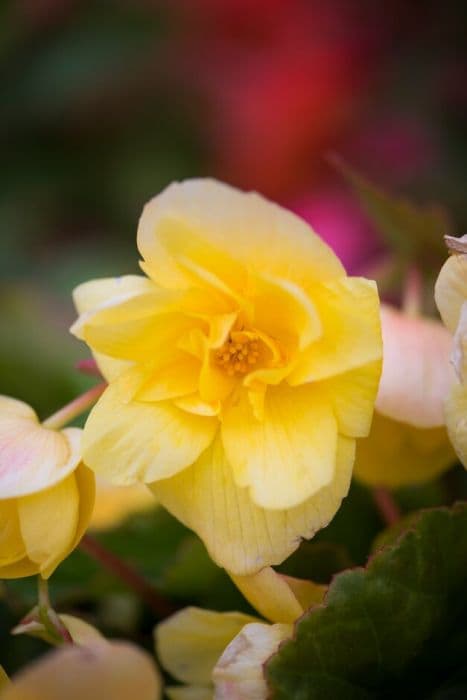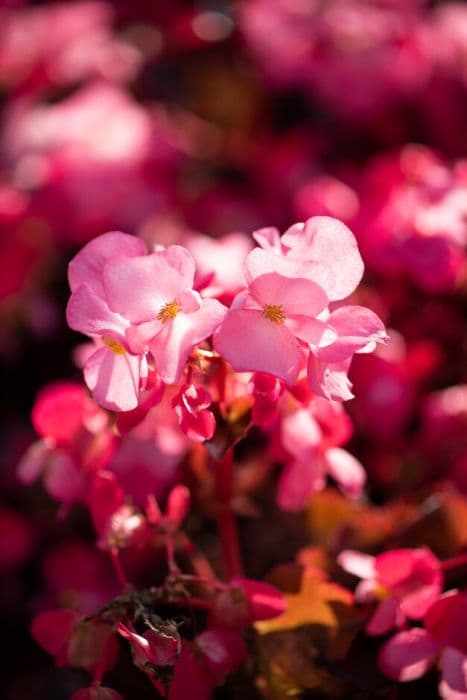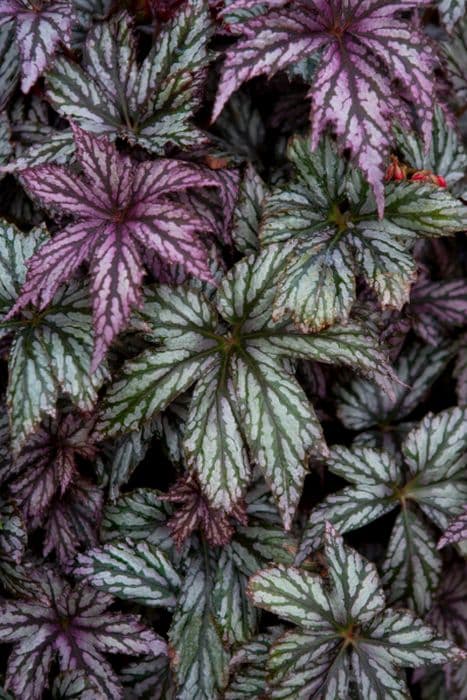Wax Begonia Begonia 'Olympia Starlet' (Olympia Series) (S)

ABOUT
Begonia 'Olympia Starlet' from the Olympia Series is a vibrant and ornamental flowering plant known for its lush foliage and showy blossoms. The leaves of this begonia are a rich green hue, glossy and slightly fleshy to the touch, exuding a lush appearance. They typically have a rounded or heart-shaped form with a subtle point at the tip, exhibiting an elegant symmetry in their growth pattern. The true stars of the Olympia Starlet are its flowers, which tend to be abundant and brilliant. The blossoms are small to medium in size and come in a range of colors, including hues of pink, red, or white. Each flower consists of multiple layers of delicate petals arranged in a tight, rose-like pattern, giving the blooms a full, rounded appearance. The Olympia Starlet begonia has a bushy, mounding growth habit, creating a dense canopy of foliage and flowers. Its overall impression is one of lushness and color, making it a popular choice for adding a dash of vibrancy to gardens and living spaces. Its versatile nature allows it to be planted in garden beds, hanging baskets, or containers, where it serves as a beautiful focal point or complementary plant to others in a decorative arrangement.
About this plant
 Names
NamesFamily
Begoniaceae
Synonyms
Fibrous Begonia, Wax Begonia, Begonia 'Olympia Starlet'
Common names
I'm sorry, but there is no alternative scientific name for the cultivar Begonia 'Olympia Starlet' from the Olympia Series; the provided name is a cultivar name, not a scientific species name, and cultivars typically do not have scientific synonyms.
 Toxicity
ToxicityTo humans
Begonias, including the Begonia 'Olympia Starlet', are known to contain insoluble oxalates which can be toxic if ingested. If parts of the plant are consumed, it can lead to symptoms such as irritation of the mouth, lips, throat, and tongue. Ingesting the plant may also result in difficulty swallowing, vomiting, and a burning sensation in the oral cavity. These symptoms are generally not life-threatening, but medical attention should be sought if ingestion occurs to manage any adverse reactions effectively.
To pets
Begonias, including the Begonia 'Olympia Starlet', are toxic to pets due to the presence of insoluble oxalates. If a pet ingests any part of the plant, it may experience symptoms such as oral irritation, drooling, vomiting, and difficulty swallowing. In more severe cases, ingestion can lead to kidney failure and other complications. It is important to keep this plant out of reach of pets and seek veterinary attention immediately if you suspect your pet has consumed any part of a begonia.
 Characteristics
CharacteristicsLife cycle
Annuals
Foliage type
Evergreen
Color of leaves
Green
Flower color
Pink
Height
6-12 inches (15-30 cm)
Spread
6-12 inches (15-30 cm)
Plant type
Herb
Hardiness zones
10
Native area
South America
Benefits
 General Benefits
General Benefits- Attractive Foliage - The Begonia 'Olympia Starlet' has colorful and decorative leaves that enhance the aesthetic of any garden or indoor setting.
- Flowering Plant - It produces vibrant flowers, adding a splash of color and visual interest to the area.
- Shade Tolerance - This variety can thrive in shaded areas where other plants might not grow as well, offering versatility in landscaping.
- Ease of Care - Begonias are generally low-maintenance, making them suitable for both novice and experienced gardeners.
- Container Gardening - They are ideal for container gardening, allowing for decorative arrangements on patios, balconies, or indoors.
- Drought Resistance - Once established, some Begonia varieties can tolerate periods of drought, requiring less frequent watering.
- Non-Invasive - Begonias are known for staying within their bounds, which helps in maintaining garden design without the worry of aggressive spreading.
- Pest Resistance - They are relatively resistant to many common garden pests, reducing the need for chemical treatments.
- Seasonal Interest - With their prolonged blooming period, Begonias offer visual interest throughout the growing season.
- Versatile Plant - Aside from using as bedding plants, Begonias can also be used in hanging baskets and as accent plants.
 Medical Properties
Medical PropertiesThis plant is not used for medical purposes.
 Air-purifying Qualities
Air-purifying QualitiesThis plant is not specifically known for air purifying qualities.
 Other Uses
Other Uses- Begonias can be used in miniature gardens to provide a splash of color and the illusion of full-sized garden flowers on a smaller scale.
- The unique patterns and colors of begonia leaves can serve as inspiration for artists and designers, often influencing fabric patterns, wallpaper designs, or artwork.
- Begonia enthusiasts may participate in competitive shows, grooming their plants meticulously to win awards for form, color, and presentation.
- As a teaching tool in horticultural classes, begonias like the 'Olympia Starlet' can be used to demonstrate hybridization, plant care, and propagation techniques.
- They can be used in floral arrangements as live potted additions for long-lasting color and visual interest, contrasting with the cut flowers.
- In crafting, the leaves and flowers of the begonia can be pressed and preserved for use in making bookmarks, cards, or other decorative paper items.
- Begonias can serve as the subject for macro photography, offering a detailed look at their intricate flower and leaf patterns.
- For a unique dining centerpiece, a potted begonia plant can add an organic, living touch to the table scape, complementing the meal's presentation.
- Gardeners can collect and exchange begonia seeds, enjoying the hobby of cultivating different varieties and sharing their passion for the plants.
- They can be planted in outdoor dollhouses or fairy gardens to create enchanting miniature scenes that integrate live plants.
Interesting Facts
 Feng Shui
Feng ShuiThe Begonia is not used in Feng Shui practice.
 Zodiac Sign Compitability
Zodiac Sign CompitabilityThe Begonia is not used in astrology practice.
 Plant Symbolism
Plant Symbolism- Caution: Begonias often symbolize warning or caution. The 'Olympia Starlet' Begonia could be a plant that reminds the gardener to be aware of potential issues or to proceed carefully in certain aspects of life.
- Harmony: The balanced growth of the 'Olympia Starlet' Begonia suggests harmony. This could represent finding balance and peace in one's personal or professional life.
- Individuality: With its unique flowering pattern, the Begonia might be seen as a celebration of one's individuality and the encouragement to stand out from the crowd.
- Uniqueness: 'Olympia Starlet', like other Begonias, may be seen as a symbol of uniqueness, reflecting the distinctive features of its blossoms and foliage that set it apart from other plants.
 Water
WaterFor Begonia 'Olympia Starlet', maintain moist but not soggy soil, typically watering once a week. During active growth in spring and summer, check the soil more frequently, as the top inch should dry out slightly before watering again. Decrease watering in fall and winter, allowing the soil to dry out more between waterings. When watering, use room temperature water, and apply it directly to the soil, avoiding the leaves to prevent disease. Depending on the pot size and environmental conditions, a general rule can be to use around 8-16 ounces of water per week, adjusting as needed based on the plant's response and the humidity of the environment.
 Light
LightBegonias like the 'Olympia Starlet' prefer bright, indirect light for optimal growth. Direct sunlight can scorch their leaves, so placing them in a spot that receives filtered light, like near a north or east-facing window, is ideal. Avoid deep shade as this can lead to leggy growth and fewer flowers.
 Temperature
TemperatureThe ideal temperature range for Begonia 'Olympia Starlet' is between 60 and 75 degrees Fahrenheit. These plants can tolerate minimum temperatures down to around 50 degrees Fahrenheit, but should not be exposed to temperatures below this as it can cause damage. Maximum temperatures should not exceed 86 degrees Fahrenheit, and the plant should be kept away from drafts and sudden temperature changes.
 Pruning
PruningBegonia 'Olympia Starlet' should be pruned to remove dead or fading flowers and leaves to encourage new growth and maintain a compact shape. Light pruning can be carried out throughout the growing season as needed. The best time for more substantial pruning is in the spring before new growth begins, which can rejuvenate an overgrown plant and stimulate flowering.
 Cleaning
CleaningAs needed
 Soil
SoilThe best soil mix for Wax Begonia is a light, well-draining potting mix with peat moss, perlite, and compost. The soil should have a slightly acidic to neutral pH, ideally between 5.5 and 6.5. Regular potting soil amended with these ingredients can create an ideal environment for healthy root growth and adequate moisture retention.
 Repotting
RepottingWax Begonias should be repotted every 1 to 2 years, preferably in the springtime. They can become root-bound, so it's important to upgrade them to a slightly larger pot with fresh soil mix to promote continued growth.
 Humidity & Misting
Humidity & MistingWax Begonias prefer moderate to high humidity levels, ideally between 50% and 70%. They thrive when the ambient moisture in the air is consistent but not excessively high, as overly damp conditions can lead to fungal issues.
 Suitable locations
Suitable locationsIndoor
Keep in bright indirect light, well-draining soil, regular watering.
Outdoor
Plant in partial shade, rich moist soil, protect from frost.
Hardiness zone
10-11 USDA
 Life cycle
Life cycleThe life cycle of Begonia 'Olympia Starlet' begins with seed germination, which requires warm, humid conditions to initiate growth. Once sprouted, the seedlings develop into juvenile plants with characteristic asymmetrical begonia leaves, during which time they require consistent moisture and protection from direct sunlight. As the plants mature, they enter the vegetative growth stage, producing lush, green foliage and preparing for the flower production phase. The flowering stage is marked by the appearance of delicate, star-shaped blooms that come in a range of colors, typically appearing in the summer months and continuing until the first frost. After blooming, if pollination occurs, the plant may produce seed capsules, containing seeds that can be collected for propagation before the plant enters a period of dormancy in response to cooler temperatures and shorter days. Throughout its life, Begonia 'Olympia Starlet' may undergo periodic cycles of pruning and rejuvenation to maintain vigor and encourage a compact, bushy growth habit.
 Propogation
PropogationPropogation time
Spring-Early Summer
Propogation: The most popular method for propagating the Begonia 'Olympia Starlet' is through stem cuttings. This can typically be done in spring or early summer when the plant is actively growing. To propagate, select a healthy stem with a few leaves and cut it just below a node using a clean, sharp pair of scissors or a knife. The cutting should be about 3 to 4 inches (about 7.6 to 10.2 centimeters) in length. Remove the leaves from the lower half of the stem to expose the nodes where roots will form. The stem cutting can then be inserted into a mix of half peat and half perlite or a well-draining potting soil. Keep the soil moist, but not soggy, and place the pot in a warm area with bright, indirect light. Roots will typically develop within a few weeks, after which the cutting can be transplanted into a regular potting mix and treated as an adult plant.



![Begonia [Bonfire]](/_next/image?url=https%3A%2F%2Fplants-admin.emdemapps.com%2Fimages%2Fplants%2F%2Fimages%2F604b6124363f0.png&w=640&q=75)


![Begonia [Devotion]](/_next/image?url=https%3A%2F%2Fplants-admin.emdemapps.com%2Fimages%2Fplants%2F%2Fimages%2F604b58183573b.png&w=640&q=75)


